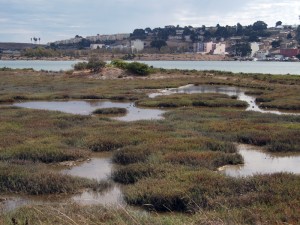Around the same time that Bayview-Hunters Point residents were fighting for the closure of the Pacific Gas and Electric Company’s power plant at Hunters Point (a fight they won in 2006), neighborhood youth were helping to shape their future community with Laurie Schoeman, project manager for Literacy for Environmental Justice (LEJ). Four hundred young people were engaged in the process of envisioning the 1,500-square-foot EcoCenter in Heron’s Head Park, says LEJ Executive Director Malik Looper. The EcoCenter, which will also serve as a neighborhood hub when it opens in a few months, is the first environmental education center in southeast San Francisco, and the first 100 percent off-grid building in the entire city.
In a community that bears the brunt of San Francisco’s waste disposal and toxic industry, this building is a model of low-impact construction. It’s topped with a living roof to capture rainwater, a photovoltaic system to generate power, and three solar hot water collectors. When a wind turbine is installed in 2010, it will provide an additional one kilowatt a day. The south-facing wall is designed as a solar thermal collector, with a massive bottom half to hold heat and a top half lined with double-glazed windows that provide views of the jetty and restored wetland.
The most unusual feature is an on-site wastewater treatment system housed inside the building. The system will serve as an educational tool as well as a working system. “It is functional, visual proof that there is no such concept of ‘away,'” says Anthony Khalil, Heron’s Head park educator. “Everything we dispose of follows a path that connects to our lives.” It’s a message that Hunters Point residents can relate to: 80 percent of San Francisco’s sewage is treated in their neighborhood.
“Placing this building in an area that has traditionally carried the city’s environmental burdens is a statement of self-determination, self-reliance, and just sustainability,” says Khalil. “That intersection is powerful.”
“The facility itself will be a teaching tool,” says Looper, “providing us with on-site solar, wind, and wastewater treatment demonstrations.” He stresses that LEJ will continue to teach students about wetlands and green living through the lens of environmental justice by telling the story of a historically polluted community and its struggle for a healthy neighborhood.
An official launch and celebration is planned for Earth Day 2010. Go to lejyouth.org for more information.

.jpg)

-300x205.jpg)
-300x150.jpg)
